
Nov . 30, 2024 09:29
Back to list
Efficient Heat Exchange Solutions for Natural Gas Applications in Energy Systems
The Importance of Natural Gas Heat Exchangers in Modern Heating Systems
Natural gas heat exchangers play a crucial role in modern heating systems, facilitating the efficient transfer of heat from one medium to another. These devices are vital in industries such as power generation, HVAC (heating, ventilation, and air conditioning), and manufacturing, where effective temperature management is essential for operational efficiency and comfort. This article explores the operational principles of natural gas heat exchangers, their applications, advantages, and future trends.
How Natural Gas Heat Exchangers Work
At the core of a heat exchanger lies the principle of conduction, where heat is transferred from a hot fluid to a cooler fluid without the two fluids mixing. In the context of natural gas heating systems, the hot fluid is typically the exhaust gases resulting from the combustion of natural gas. These exhaust gases pass through a series of tubes or plates, where they transfer heat to a secondary fluid—usually water or air—circulating in close proximity. This process raises the temperature of the secondary fluid, which can then be used for heating buildings, processes, or even generating steam for power production.
Heat exchangers are categorized into different types, including shell-and-tube, plate, and finned-tube heat exchangers. Each type has its unique design characteristics and is suited to specific applications. For example, shell-and-tube heat exchangers are commonly used in large industrial setups due to their ability to handle high-pressure and high-temperature fluids. In contrast, plate heat exchangers are often found in smaller, space-constrained environments, owing to their compact design and efficient heat transfer capabilities.
Applications of Natural Gas Heat Exchangers
Natural gas heat exchangers are employed in a variety of sectors. In residential and commercial heating, they are integral to furnaces and boilers, providing efficient warmth during colder months. In the industrial sphere, they are utilized in processes such as chemical manufacturing, oil refineries, and food production, where precise temperature control is necessary for product quality and safety.
Moreover, natural gas heat exchangers play a significant role in energy production. Combined heat and power (CHP) systems leverage these devices to optimize energy efficiency by using waste heat from electricity generation for heating purposes. Natural gas is increasingly being recognized as a cleaner alternative compared to other fossil fuels, making heat exchangers that utilize this resource vital in fostering more sustainable industrial practices.
natural gas heat exchanger

Advantages of Using Natural Gas Heat Exchangers
The benefits of natural gas heat exchangers are manifold. First and foremost, they offer high thermal efficiency, which translates to lower energy consumption and reduced operational costs. Additionally, because natural gas is generally cleaner than other fossil fuels, its use in heat exchangers can result in lower emissions of pollutants and greenhouse gases, supporting environmental sustainability.
Another significant advantage is the versatility of natural gas heat exchangers. They can be adapted for various applications, accommodating fluctuating heating demands while maintaining efficiency. Furthermore, advancements in technology have led to the development of more compact and lightweight designs, allowing for easier integration into existing systems.
Future Trends
Looking ahead, there are several trends shaping the future of natural gas heat exchangers. One notable development is the integration of smart technologies. The incorporation of IoT (Internet of Things) devices allows for real-time monitoring and optimization of heat exchanger performance. This capability enhances predictive maintenance, reducing downtime and extending the lifespan of equipment.
Additionally, as the global focus shifts towards renewable energy sources, natural gas heat exchangers will need to adapt. Researchers are exploring hybrid systems that can integrate renewable energy sources, such as solar and geothermal, with natural gas heating systems, fostering a more sustainable energy landscape.
In conclusion, natural gas heat exchangers are vital components of modern heating systems, providing efficient thermal management across various applications. As technology evolves and sustainability becomes paramount, these devices will continue to play an essential role in balancing energy efficiency, cost-effectiveness, and reduced environmental impact.
Latest news
-
Safety Valve Spring-Loaded Design Overpressure ProtectionNewsJul.25,2025
-
Precision Voltage Regulator AC5 Accuracy Grade PerformanceNewsJul.25,2025
-
Natural Gas Pressure Regulating Skid Industrial Pipeline ApplicationsNewsJul.25,2025
-
Natural Gas Filter Stainless Steel Mesh Element DesignNewsJul.25,2025
-
Gas Pressure Regulator Valve Direct-Acting Spring-Loaded DesignNewsJul.25,2025
-
Decompression Equipment Multi-Stage Heat Exchange System DesignNewsJul.25,2025

